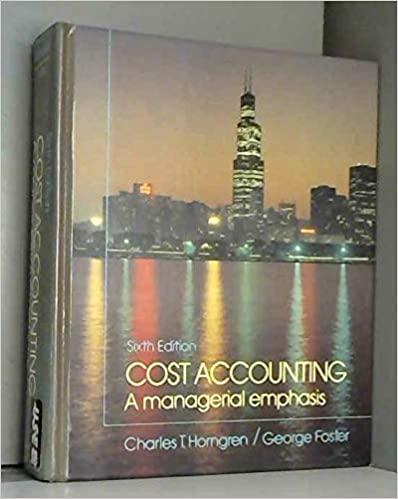



Exercise 17-10 (Algo) Using departmental overhead rates and computing gross profit LO P2 Real Cool produces air conditioners in two departments: Assembly and Finishing. Budgeted information follows. Department Budgeted Cost Allocation Base Budgeted Usage Assembly $ 312,000 Machine hours 7,800 nachine hours Finishing 27,000 Direct labor hours 4,500 direct labor hours Additional production information for two models of its air conditioners follows. Per unit Selling price Direct materials Direct labor Model A $ 580 190 240 Model T $ 600 180 250 Model T 500 4.5 MH 4 DLH Model Units produced 400 Assembly machine hours per unit 2 MH Finishing direct labor hours per unit 3 DLH 1a. Compute departmental overhead rates and determine overhead cost per unit for each model. 16. Use machine hours to allocate budgeted Assembly costs and use direct labor hours to allocate budgeted Finishing costs. 2. Compute the total product cost per unit for each model. 3. For each model compute the gross profit per unit (selling price per unit minus product cost per unit). Complete this question by entering your answers in the tabs below. Reg 1A Req 16 Req2 Reg 3 VLT ELLER Direct labor 150 248 400 250 Units produced Assembly machine hours per unit Finishing direct labor hours per unit Model A 400 2 MH Model T 500 4.5 MH 4 DLH 3 DLH 1a. Compute departmental overhead rates and determine overhead cost per unit for each model. 1b. Use machine hours to allocate budgeted Assembly costs and use direct labor hours to allocate budgeted Finishing costs. 2. Compute the total product cost per unit for each model 3. For each model compute the gross profit per unit (selling price per unit minus product cost per unit). Complete this question by entering your answers in the tabs below. Reg 1A Req 18 Reg 2 Reg 3 Compute departmental overhead rates and determine overhead cost per unit for each model. Assembly department overhead rate Finishing department overhead rate per MH por DLH Re4 18 5 ULICLE OLET LOL Direct labor 190 240 400 250 Model A Model T Units produced 400 500 Assembly machine hours per unit 2 MH 4.5 MH Finishing direct labor hours per unit 3 DLH 4 DLH 1a. Compute departmental overhead rates and determine overhead cost per unit for each model. 1b. Use machine hours to allocate budgeted Assembly costs and use direct labor hours to allocate budgeted Finishing costs. 2. Compute the total product cost per unit for each model. 3. For each model, compute the gross profit per unit (selling price per unit minus product cost per unit). Complete this question by entering your answers in the tabs below. Reg 1A 18 Req 2 Reg 3 Use machine hours to allocate budgeted Assembly costs and use direct labor hours to allocate budgeted Finishing costs. (Round "Hours per unit" to one decimal place.) Department Departmental Overhead Rate Model A Overhead Hours per Unit Allocated Model T Overhead Hours per Unit Allocated Assembly Finishing Totals 1 UIELU MOLEILLS Direct labor 240 LOU 250 Model A Model T Units produced 400 500 Assembly machine hours per unit 2 MH 4.5 MH Finishing direct labor hours per unit 3 DLH 4 DLH 1a. Compute departmental overhead rates and determine overhead cost per unit for each model. 1. Use machine hours to allocate budgeted Assembly costs and use direct labor hours to allocate budgeted Finishing costs. 2. Compute the total product cost per unit for each model. 3. For each model, compute the gross profit per unit (selling price per unit minus product cost per unit), Complete this question by entering your answers in the tabs below. Reg 1A Reg 1B kea 2 Reg 3 Compute the total product cost per unit for each model. Per Unit Direct Materials Direct Labor Overhead Product Cost per Unit Model A Model T ULT CLL Leta Direct labor 190 240 400 250 Model A Model T Units produced 400 500 Assembly machine hours per unit 2 MH 4.5 MH Finishing direct labor hours per unit 3 DLH 4 DLH 1a. Compute departmental overhead rates and determine overhead cost per unit for each model. 1b. Use machine hours to allocate budgeted Assembly costs and use direct labor hours to allocate budgeted Finishing costs, 2. Compute the total product cost per unit for each model. 3. For each model, compute the gross profit per unit (selling price per unit minus product cost per unit), Complete this question by entering your answers in the tabs below. Reg 1A Reg 18 Req 2 Req 3 For each model, compute the gross profit per unit (seling price per unit minus product cost per unit). (A negative gross profit should be indicated with a minus sign.) Selling Price Product Cost Gross Profit Per Unit Model A Model T











